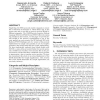38 search results - page 2 / 8 » Protection and communication abstractions for web browsers i... |
COLCOM
2008
IEEE
14 years 19 days ago
2008
IEEE
Abstract. Malicious Web content poses a serious threat to the Internet, organizations and users. Current approaches to detecting malicious Web content employ high-powered honey cli...
USS
2008
14 years 1 months ago
2008
Many web sites embed third-party content in frames, relying on the browser's security policy to protect them from malicious content. Frames, however, are often insufficient i...
ACNS
2006
Springer
14 years 4 months ago
2006
Springer
Abstract. While web-based communications (e.g., webmail or web chatrooms) are increasingly protected by transport-layer cryptographic mechanisms, such as the SSL/TLS protocol, ther...
ICWS
2009
IEEE
13 years 8 months ago
2009
IEEE
Traditionally, the composition of Web services to create mashups has been achieved by using an application server as a mediator between a client browser and services. To avoid thi...
CCS
2008
ACM
14 years 25 days ago
2008
ACM
Single-Sign-On (SSO) protocols enable companies to establish a federated environment in which clients sign in the system once and yet are able to access to services offered by dif...



